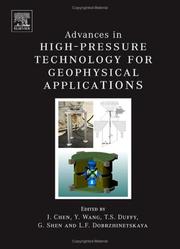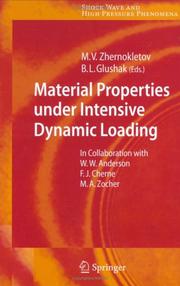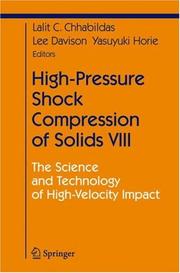| Listing 1 - 10 of 11 | << page >> |
Sort by
|

ISBN: 0080457665 9780080457666 1280638427 9781280638428 9786610638420 661063842X 9780444519795 0444519793 Year: 2005 Publisher: Boston Elsevier
Abstract | Keywords | Export | Availability | Bookmark
 Loading...
Loading...Choose an application
- Reference Manager
- EndNote
- RefWorks (Direct export to RefWorks)
High-pressure mineral physics is a field that is strongly driven by the development of new technology. Fifty years ago, when experimentally achievable pressures were limited to just 25 GPa, little was know about the mineralogy of the Earth's lower mantle. Silicate perovskite, the likely dominant mineral of the deep Earth, was identified only when the high-pressure techniques broke the pressure barrier of 25 GPa in 1970's. However, as the maximum achievable pressure reached beyond one Megabar (100 GPa) and even to the pressure of Earth's core on minute samples, new discoveries increasingly were
Mineralogy. --- Mineralogical chemistry. --- Geophysics. --- Materials at high pressures.
Book
ISBN: 1139031988 1108228070 1108229239 1108229468 1108229921 1108229697 1108230849 Year: 2017 Publisher: Cambridge : Cambridge University Press,
Abstract | Keywords | Export | Availability | Bookmark
 Loading...
Loading...Choose an application
- Reference Manager
- EndNote
- RefWorks (Direct export to RefWorks)
Dynamic compression is an experimental technique with interdisciplinary uses, ranging from enabling the creation of ultracondensed matter under previously impossible conditions to understanding the likely cause of unusual planetary magnetic fields. Readers can now gain an intuitive understanding of dynamic compression; clear and authoritative chapters examine its history and experimental method, as well as key topics including dynamic compression of liquid hydrogen, rare gas fluids and shock-induced opacity. Through an up-to-date history of dynamic compression research, Nellis also clearly shows how dynamic compression addresses and will continue to address major unanswered questions across the scientific disciplines. The past and future role of dynamic compression in studying and making materials at extreme conditions of pressure, density and temperature is made clear, and the means of doing so are explained in practical language perfectly suited for researchers and graduate students alike.
Condensed matter. --- Materials at high pressures. --- High pressure (Science) --- High pressure geosciences.
Book
ISBN: 0128014423 0128013001 9780128014424 9780128013007 Year: 2017 Publisher: Amsterdam, Netherlands ; Oxford, England ; Cambridge, Massachusetts : Elsevier,
Abstract | Keywords | Export | Availability | Bookmark
 Loading...
Loading...Choose an application
- Reference Manager
- EndNote
- RefWorks (Direct export to RefWorks)
Materials --- Extreme environments. --- Materials at high pressures. --- Testing. --- High pressure (Technology) --- Strength of materials --- Environments, Extreme --- Ecology
Book
ISBN: 3038269891 9783038269892 9783038355199 3038355194 Year: 2015 Publisher: Pfaffikon, Switzerland : TTP,
Abstract | Keywords | Export | Availability | Bookmark
 Loading...
Loading...Choose an application
- Reference Manager
- EndNote
- RefWorks (Direct export to RefWorks)
Materials --- Materials at high pressures --- Shock (Mechanics) --- Mechanical shock --- Damping (Mechanics) --- Impact --- Mechanics --- Strains and stresses --- Vibration --- Dynamic testing
Multi
ISBN: 9789811924200 9789811924194 9789811924217 9789811924224 Year: 2022 Publisher: Singapore Springer Nature
Abstract | Keywords | Export | Availability | Bookmark
 Loading...
Loading...Choose an application
- Reference Manager
- EndNote
- RefWorks (Direct export to RefWorks)
This book offers historical and state-of-the-art molecular spectroscopy methods and applications in dynamic compression science, aimed at the upcoming generation in physical sciences involved in studies of materials at extremes. It begins with addressing the motivation for probing shock compressed molecular materials with spectroscopy and then reviews historical developments and the basics of the various spectroscopic methods that have been utilized. Introductory chapters are devoted to fundamentals of molecular spectroscopy, overviews of dynamic compression technologies, and diagnostics used to quantify the shock compression state during spectroscopy experiments. Subsequent chapters describe all the molecular spectroscopic methods used in shock compression research to date, including theory, experimental details for application to shocked materials, and difficulties that can be encountered. Each of these chapters also includes a section comparing static compression results. The last chapter offers an outlook for the future, which leads the next-generation readers to tackling persistent problems.
Solid state physics --- Spectrometric and optical chemical analysis --- IR spectroscopie --- fysica --- Materials at high pressures. --- Molecular spectroscopy.
Book
ISBN: 1783264314 1848163061 9781848163065 9781848163058 1848163053 Year: 2014 Publisher: London : Imperial College Press,
Abstract | Keywords | Export | Availability | Bookmark
 Loading...
Loading...Choose an application
- Reference Manager
- EndNote
- RefWorks (Direct export to RefWorks)
High-pressure materials research has been revolutionized in the past few years due to technological breakthroughs in the diamond anvil cell (DAC), shock wave compression and molecular dynamic simulation (MD) methods. The application of high pressure, especially together with high temperature, has revealed exciting modifications of physical and chemical properties even in the simplest molecular materials. Besides the fundamental importance of these studies to understand the composition and the dynamics of heart and planets' interior, new materials possessing peculiar characteristics of hardness

ISBN: 1280955619 9786610955619 3540368450 3540368442 Year: 2006 Publisher: Berlin ; New York : Springer,
Abstract | Keywords | Export | Availability | Bookmark
 Loading...
Loading...Choose an application
- Reference Manager
- EndNote
- RefWorks (Direct export to RefWorks)
Understanding the physical and thermomechanical response of materials subjected to intensive dynamic loading is a challenge of great significance in engineering today. This volume assumes the task of gathering both experimental and diagnostic methods in one place, since not much information has been previously disseminated in the scientific literature. This book will thus be an invaluable companion for both the seasoned practioner as well as for the novice entering the field of experimental shock physics.
Materials --- Shock (Mechanics) --- Materials at high pressures. --- Dynamic testing. --- High pressure (Technology) --- Strength of materials --- Mechanical shock --- Damping (Mechanics) --- Impact --- Mechanics --- Strains and stresses --- Vibration --- Dynamic loading (Materials) --- Loading, Dynamic (Materials) --- Loads, Dynamic (Materials) --- Dynamic testing --- Testing

ISBN: 1280638427 9786610638420 0080457665 0444519793 9780080457666 9780444519795 9781280638428 661063842X Year: 2005 Publisher: Amsterdam ; Boston : Elsevier,
Abstract | Keywords | Export | Availability | Bookmark
 Loading...
Loading...Choose an application
- Reference Manager
- EndNote
- RefWorks (Direct export to RefWorks)
High-pressure mineral physics is a field that is strongly driven by the development of new technology. Fifty years ago, when experimentally achievable pressures were limited to just 25 GPa, little was know about the mineralogy of the Earth's lower mantle. Silicate perovskite, the likely dominant mineral of the deep Earth, was identified only when the high-pressure techniques broke the pressure barrier of 25 GPa in 1970's. However, as the maximum achievable pressure reached beyond one Megabar (100 GPa) and even to the pressure of Earth's core on minute samples, new discoveries increasingly were
Mineralogy. --- Mineralogical chemistry. --- Geophysics. --- Materials at high pressures. --- Geological physics --- Terrestrial physics --- Chemistry, Mineralogical --- Mineral chemistry --- High pressure (Technology) --- Strength of materials --- Earth sciences --- Physics --- Geochemistry --- Physical geology --- Crystallography --- Minerals
Book
ISBN: 9048134064 9048134080 Year: 2010 Publisher: Dordrecht, The Netherlands : Springer,
Abstract | Keywords | Export | Availability | Bookmark
 Loading...
Loading...Choose an application
- Reference Manager
- EndNote
- RefWorks (Direct export to RefWorks)
recently discovered advantages of amorphous forms of medicines/pharmaceutical products which focused a significant part of industry-related efforts on the GFA (Glass Forming Ability) and the glass temperature (T) versus pressure g dependences. 1 b ? 0 ? ? o ? P ? Pg P ? Pg 0 ? ? ? ? T (P ) = F (P )D (P ) =T 1 + exp ? g g ? 0 ? ? ? ? c + Pg ? ? ? ? 400 1 b 0 o ? ? ? ? P ? P P ? P g g 0 ? ? ? ? T (P ) = F (P )D (P ) =T 1 + exp ? g g 0 ? ? ? ? c ? + P max g ? ? ? ? T ~7 GPa g max P ~ 304 K Liquid g 300 1 HS glass 0 200 -1 mSG ?=0. 044 Liquid -2 100 -3 glass ?=0. 12 -1. 2 -0. 9 -0. 6 -0. 3 0. 0 log T 10 scaled -1 0 1 2 3 4 5 6 7 8 9 10 11 12 P (GPa) g 19 Figure 1. T he pressure evolution of the glass temperature in gl Th ye s cerol ol . id curve shows the parameterization of experimental data via the novel, modifie d Glat Sizm elon type equation, given in the Figure.
Materials -- Thermal properties -- Congresses. --- Materials at high pressures -- Congresses. --- Phase transformations (Statistical physics) -- Congresses. --- Materials at high pressures --- Materials --- Phase transformations (Statistical physics) --- Physics --- Engineering & Applied Sciences --- Atomic Physics --- Applied Physics --- Physical Sciences & Mathematics --- Thermal properties --- Physics. --- Planetology. --- Geotechnical engineering. --- Condensed matter. --- Solid state physics. --- Spectroscopy. --- Microscopy. --- Complexity, Computational. --- Condensed Matter Physics. --- Complexity. --- Geotechnical Engineering & Applied Earth Sciences. --- Solid State Physics. --- Spectroscopy and Microscopy. --- Engineering. --- Planetary sciences --- Planetology --- Construction --- Industrial arts --- Technology --- Computational complexity. --- Analysis, Spectrum --- Spectra --- Spectrochemical analysis --- Spectrochemistry --- Spectroscopy --- Chemistry, Analytic --- Interferometry --- Optics --- Radiation --- Wave-motion, Theory of --- Absorption spectra --- Light --- Spectroscope --- Solids --- Engineering, Geotechnical --- Geotechnics --- Geotechnology --- Engineering geology --- Analysis, Microscopic --- Light microscopy --- Micrographic analysis --- Microscope and microscopy --- Microscopic analysis --- Optical microscopy --- Complexity, Computational --- Electronic data processing --- Machine theory --- Condensed materials --- Condensed media --- Condensed phase --- Materials, Condensed --- Media, Condensed --- Phase, Condensed --- Liquids --- Matter --- Qualitative --- Spectrometry --- Analytical chemistry

ISBN: 1280306114 9786610306114 3540271686 3540228667 3642061672 Year: 2005 Publisher: New York : Springer,
Abstract | Keywords | Export | Availability | Bookmark
 Loading...
Loading...Choose an application
- Reference Manager
- EndNote
- RefWorks (Direct export to RefWorks)
Research in the field of shock physics and ballistic impact has always been intimately tied to progress in development of facilities for accelerating projectiles to high velocity and instrumentation for recording impact phenomena. The chapters of this book, written by leading US and European experts, cover a broad range of topics and address researchers concerned with questions of material behaviour under impulsive loading and the equations of state of matter, as well as the design of suitable instrumentation such as gas guns and high-speed diagnostics. Applications include high-speed impact dynamics, the inner composition of planets, syntheses of new materials and materials processing. Among the more technologically-oriented applications treated is the testing of the flight characteristics of aeroballistic models and the assessment of impacts in the aerospace industry.
Materials --- Materials at high pressures. --- Shock (Mechanics) --- Compression testing. --- Mechanical shock --- Damping (Mechanics) --- Impact --- Mechanics --- Strains and stresses --- Vibration --- High pressure (Technology) --- Strength of materials --- Compression strength testing of materials --- Compression testing of materials --- Compressive strength testing of materials --- Compressive testing of materials --- Testing --- Mechanical engineering. --- Condensed Matter Physics. --- Measurement Science and Instrumentation. --- Classical and Continuum Physics. --- Mechanical Engineering. --- Engineering, Mechanical --- Engineering --- Machinery --- Steam engineering --- Condensed matter. --- Physical measurements. --- Measurement . --- Continuum physics. --- Classical field theory --- Continuum physics --- Physics --- Continuum mechanics --- Measuring --- Mensuration --- Mathematics --- Technology --- Metrology --- Physical measurements --- Measurements, Physical --- Mathematical physics --- Measurement --- Condensed materials --- Condensed media --- Condensed phase --- Materials, Condensed --- Media, Condensed --- Phase, Condensed --- Liquids --- Matter --- Solids
| Listing 1 - 10 of 11 | << page >> |
Sort by
|

 Search
Search Feedback
Feedback About UniCat
About UniCat  Help
Help News
News